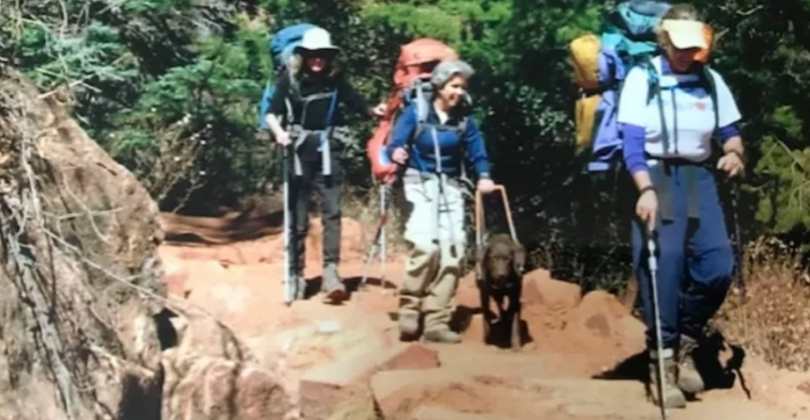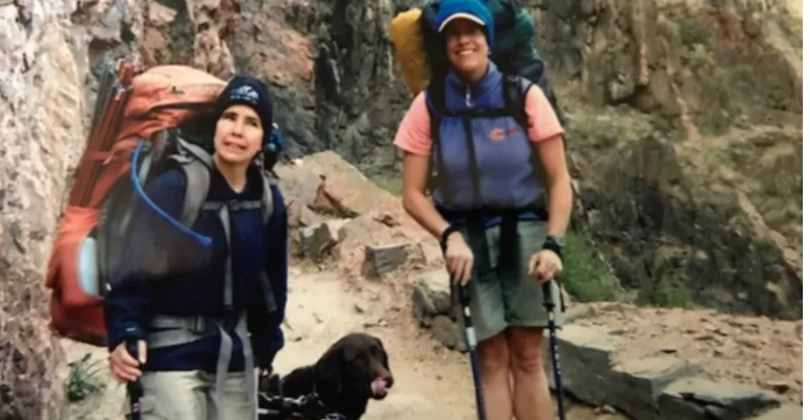Train Your Guide Dog to Hike

The primary task that Guide Dogs are taught is how to work in urban settings. For those that want to get away from the crowds and cars this creates a dilemma. I love the outdoors and have always enjoyed hiking on trails from hiking down into the Grand Canyon to the tops of 14,000 foot peaks in Colorado. Here, I'm going to teach you how to train your guide dog how to hike and what equipment you should keep on hand.
I am not a professional dog trainer. The tips in this article are skills rooted from the principles taught in "Seeing Eye" and "Guide Dogs for the Blind." For some of the dogs, it may be new ground, so be patient, give lots of praise, and remember treats.
Below are a few items that I highly recommend to help you get outside and onto trails:
- An adjustable trekking pole
- Guide dog
- Friend
- Treats
You want to use an adjustable trekking pole in your right hand to help with your balance and to locate obstacles. It's also always wise to scout a trail with a friend first if you think you want to try hiking a trail solo. I mostly hike with friends because it's hard to find public transportation to hiking trails. I prefer to have my friend hike behind me as I find that my dogs work better if they aren't watching someone in front of them.
When I decided to try hiking with my first dog, we began on a wide gravel road. She wanted to sniff everything, so I used her gentle leader to discourage so much sniffing in harness.
After she was comfortable on the gravel road we found a narrower trail with rolling hills, and still minimal obstacles.
If there are curves in the trail and she found the correct trail I gave her lots of praise and sometimes a treat. Our command is "find the trail."
When we were both comfortable on easy trails, we looked for trails with some small rocks, roots and logs. Dogs are taught to look for the clearest path, so my dogs look for a way around rocks. It was helpful for me to receive feed back from my sighted friend, at first, to know about obstacles we would encounter, so we could figure out a strategy to safely clear the obstacle. Sometimes, my dog had a tendency to stop a foot from the obstacle. We had to show her that it was okay to get close to the rock or log. When she would take me to the rock, I would praise her, give her a treat, and have her look for a way around the rock. If there wasn't a way around, I put my hiking stick and my right foot on the rock and tell her to "Hopup."
When we encountered logs, I find the side of the log closest to me, give her praise for stopping at the log. Then, I find top of the log and step over with my hiking pole. I feel with my pole how wide the log is and feel with my hands on the log to be sure there aren't any sharp sticks protruding out of the log. This is information my sighted friends can also tell me. Once I have information about the log, I tell my dog to jump over the log. Then, I place my hiking pole on the log, step on it, and move my pole to the far side of the log and step down.
Once I've cleared an obstacle, especially if my dog has found a clear path (my sighted friend will tell me we have cleared a rock) then I can praise my dog for a job well done.

When hiking steeper terrain, I adjust my pole shorter for going up hill and longer for coming down. I'm often slower hiking downhill in order to be sure my footing is secure.
Once your dog gets the hang of hiking, your sighted friends can just hike along with me, without having to provide many cues. These are the basic tips that have allowed me leave the pavement for dirt trails and enjoy the smells, sounds, and exertion of adventuring in the great outdoors.